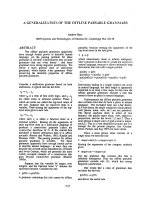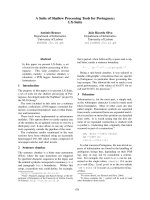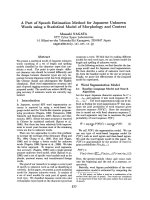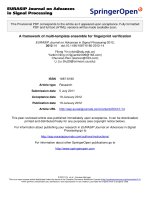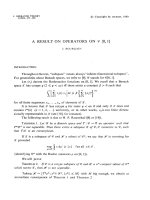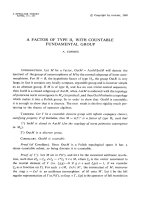Báo cáo toán học: "A generalization of Simion-Schmidt’s bijection for restricted permutations" doc
Bạn đang xem bản rút gọn của tài liệu. Xem và tải ngay bản đầy đủ của tài liệu tại đây (127.43 KB, 9 trang )
A generalization of Simion-Schmidt’s bijection for
restricted permutations
Astrid Reifegerste
Institut f¨ur Mathematik, Universit¨at Hannover
Welfengarten 1, D-30167 Hannover, Germany
Submitted: Mar 27, 2003; Accepted: Jun 9, 2003; Published: Jun 18, 2003
MR Subject Classifications: 05A05, 05A15
Abstract. We consider the two permutation statistics which count the distinct pairs obtained
from the final two terms of occurrences of patterns τ
1
···τ
m−2
m(m − 1) and τ
1
···τ
m−2
(m − 1)m in a
permutation, respectively. By a simple involution in terms of permutation diagrams we will prove their
equidistribution over the symmetric group. As a special case we derive a one-to-one correspondence
between permutations which avoid each of the patterns τ
1
···τ
m−2
m(m − 1) ∈S
m
and those which avoid
each of the patterns τ
1
···τ
m−2
(m − 1)m ∈S
m
.Form = 3 this correspondence coincides with the
bijection given by Simion and Schmidt in [11].
1 Introduction
Recently, a lot of work has been done investigating permutations with restrictions on
the patterns they contain. Given a permutation π ∈S
n
and a permutation τ ∈S
m
,
an occurrence of τ in π is an integer sequence 1 ≤ i
1
<i
2
< < i
m
≤ n such that
the letters of the subword π
i
1
π
i
2
···π
i
m
are in the same relative order as the letters of
τ.Inthiscontext,τ is called a pattern. If there is no occurrence at all we say that π
avoids τ or, alternatively, π is τ-avoiding. We write S
n
(τ)todenotethesetofτ-avoiding
permutations in S
n
and, more generally, S
n
(T ) for the set of all permutations of length n
which avoid each pattern of the set T .
A central theme in the theory of pattern-avoiding permutations is to classify all patterns
up to Wilf-equivalence. Two patterns τ
1
and τ
2
are called Wilf-equivalent if they are
equally restrictive, that is, |S
n
(τ
1
)| = |S
n
(τ
2
)| for all n ∈ N. The first major result dealing
with this problem states that 123 and 132 are Wilf-equivalent. (By obvious symmetry
arguments, this implies that S
3
is one Wilf-class.) The first explicit bijection between the
sets S
n
(123) and S
n
(132) was presented by Simion and Schmidt [11]. We will generalize
their correspondence.
In [9] and [10], the diagram of a permutation has been used to study certain forbidden
the electronic journal of combinatorics 9(2) (2003), #R14 1
patterns. Given a permutation π ∈S
n
,weobtainitsdiagram as follows. Let π be
represented by an n × n array with a dot in each of the squares (i, π
i
). Shadow the
squares in each row from the dot and eastwards and the squares in each column from
the dot and southwards. The diagram is defined to be the region left unshaded after
this procedure. By construction, the connected components of a diagram form Young
diagrams. For a diagram square, its rank is defined to be the number of dots northwest
of it. Clearly, connected diagram squares have the same rank.
In this paper, permutation diagrams play a major role again. Section 2 will show that
diagram squares are closely related to occurrences of patterns τ ∈S
m
with τ
m−1
τ
m
=
m(m − 1) or τ
m−1
τ
m
=(m − 1)m. The distinct pairs arising from the last two terms of all
occurrences of τ
1
···τ
m−2
m(m − 1) in a permutation correspond to the diagram squares
of rank at least m − 2. On the other hand, it suffices to know the distinct pairs arising
from the last two terms of all occurrences of τ
1
···τ
m−2
(m − 1)m in order to complete a
permutation array which contains merely the diagram squares of rank at most m − 3.
We will prove that the permutation statistics counting the number of these pairs have
the same distribution over the symmetric group. In Section 3, a bijection on S
n
will be
established which respects these statistics. In particular, it will be shown that there are as
many permutations in S
n
which avoid all patterns τ ∈S
m
with τ
m−1
= m and τ
m
= m−1
as permutations which avoid all patterns τ ∈S
m
with τ
m−1
= m − 1andτ
m
= m.For
m = 3 the correspondence coincides with Simion-Schmidt’s bijection.
2 Diagrams and occurrences of patterns
For m ≥ 2 define the pattern sets
A
m
= {τ ∈S
m
: τ
m−1
= m, τ
m
= m−1} and B
m
= {τ ∈S
m
: τ
m−1
= m−1,τ
m
= m}.
For a permutation π ∈S
n
,denotebyO
A
m
(π)andO
B
m
(π) the sets of pairs (i
m−1
,i
m
)
obtained from an occurrence (i
1
, ,i
m−1
,i
m
) of a pattern belonging to A
m
and B
m
,re-
spectively. Furthermore, we define a
m
(π)=|O
A
m
(π)| and b
m
(π)=|O
B
m
(π)|.Incaseof
a
m
(π)=0(orb
m
(π)=0),π avoids each pattern of A
m
(or B
m
). Note that a
2
(π)counts
the inversions in π while b
2
(π) counts how often π contains the pattern 12. For m>2,
the numbers a
m
(π)andb
m
(π), respectively, are not equal in general to the total numbers
of occurrences of A
m
-patterns or B
m
-patterns in π.
For example, the pattern 1243 occurs in π =81426357∈S
8
at the positions (2, 3, 5, 7),
(2, 4, 5, 6), and (2, 4, 5, 7); (3, 4, 5, 7) is the only occurrence of 2143. Furthermore, π con-
tains eight increasing subsequences of length 4 whose last two elements are at the posi-
tions (5, 8), (6, 7), (6, 8) or (7, 8). Finally, there are three occurrences of the pattern 2134,
namely, (3, 4, 5, 8), (3, 4, 7, 8), and (3, 6, 7, 8). Hence a
4
(π)=2andb
4
(π)=4.
The number a
m
(π) can be read off immediately from the ranked diagram of π.
Proposition 1 Let π ∈S
n
be a permutation. Then a
m
(π) equals the number of diagram
squares of rank at least m − 2. In particular, π avoids all patterns of A
m
if and only if
every diagram square is of rank at most m − 3.
the electronic journal of combinatorics 9(2) (2003), #R14 2
Proof. It follows from the diagram construction that any diagram square (i, j)ofrankat
least m − 2 corresponds to an occurrence of a pattern of A
m
whose final terms are just
i, k where π
k
= j. ✷
By definition, the number b
m
(π) counts the number of non-inversions on the positions
of π whose letters are greater than at least m − 2 letters to their left. (Here a pair (i, j)
is called a non-inversion if i<jand π
i
<π
j
.) All the information about a permutation
is encoded in the diagram squares of rank at most m − 3andtheelementsofO
B
m
(π).
Proposition 2 For each m ≥ 2,apermutationπ ∈S
n
can be recovered completely from
the diagram squares having rank at most m − 3 and the pairs (i, j) ∈ O
B
m
(π).
Proof. For any m ≥ 2, let D be the set of all diagram squares of rank at most m − 3. The
proof is based on the following procedure.
First represent the elements of D as white squares in an n × n array, shaded elsewhere.
Starting from the top and proceeding row by row, put a dot in the leftmost shaded square
such that there is exactly one dot in each column. By definition of permutation diagrams,
this yields the array representation of a permutation that coincides with π at all positions
i for which there are at most m − 3 integers j<iwith π
j
<π
i
. As mentioned before
the Proposition, the pairs (i, j) ∈ O
B
m
(π) are exactly the non-inversions of the subword
consisting of all letters of π having at least m − 2 smaller letters to their left. Thus we
obtain the array representation of π by marking all dots having more than m − 3dots
northwest and rearranging these dots in a way that the marked dot contained in the ith
row lies strictly to the left of the marked dot contained in the jth row if and only if
(i, j) ∈ O
B
m
(π). ✷
Remark 3 An efficient way to arrange the marked dots is the following one. Let r
1
<
r
2
< < r
s
be the indices of rows containing a marked dot, and c
1
>c
2
> > c
s
the indices of columns with a marked dot. Furthermore, let e
i
be the number of pairs in
O
B
m
(π) whose first component equals r
i
.Fori =1, ,s,setc
i
= c
e
i
+1
, delete c
e
i
+1
from
the sequence c, and renumber the sequence terms. Put the dots in the squares (r
i
,c
i
)
where 1 ≤ i ≤ s. Note that the second component of the elements of O
B
m
(π)hasno
relevance for this procedure.
Example 4 Let π =38510241967∈S
10
and m = 5. The leftmost array shows the
ranked permutation diagram of π. All the occurrences of B
5
-patterns end with (9, 10).
Thus we obtain:
r
r
r
r
r
r
r
r
r
r
0
0
0
0
0
0
0
0
0
0
1
1
1111
22 3
55
r
r
r
❜
r
r
r
❜
❜
❜
r
r
r
❜
r
r
r
❜
❜
❜
:
−→
4
8
9
10
Figure 1 Recovering of a permutation
the electronic journal of combinatorics 9(2) (2003), #R14 3
Black dots represent the elements of π which exceed at most two elements to their left.
Note that (9, 10) is the only non-inversion on the elements represented by white dots in
the right-hand array. (The sorting routine yields c
=(10, 9, 6, 7) since e =(0, 0, 1, 0).)
3 The bijection
The properties of permutation diagrams given in the previous section are essential for
the construction of a bijection Φ
m
which proves
Theorem 5 |{π ∈S
n
: a
m
(π)=k}| = |{π ∈S
n
: b
m
(π)=k}| for all n and k.
Let π ∈S
n
be a permutation. Denote by D
1
the set of its diagram squares of rank at
most m − 3, and by D
2
the set of the remaining diagram squares.
Now define σ =Φ
m
(π) to be the permutation in S
n
whose set of diagram squares of
rank at most m − 3equalsD
1
, and which has as many occurrences (i
1
, ,i
m−1
,i
m
)of
B
m
-patterns as there are squares (i
m−1
, ∗)inD
2
.
Before analysing this map, let us give an example.
Example 6 Consider π =38510241967∈S
10
again. For m =5,themapΦ
m
takes
π to the permutation σ =38592416107:
r
r
r
r
r
r
r
r
r
r
0
0
0
0
0
0
0
0
0
0
1
1
1111
22 3
55
r
r
r
r
r
r
r
r
r
r
−→
Figure 2 Bijection Φ
5
, applied to π =38510241967
The diagram squares having rank at most 2 coincide for π and σ. Furthermore, we obtain
O
B
5
(σ)={(4, ∗), (8, ∗), (8, ∗)}. (Note that the second components will be not equal in
general to the column indices of the diagram squares of π having rank at least 3.) The
construction of σ’s array is completed as described in the proof of Proposition 2. With the
notations introduced in Remark 3, we have r =(4, 8, 9, 10), c =(10, 9, 7, 6), e =(1, 2, 0, 0),
and hence c
=(9, 6, 10, 7).
As discussed in the proof of Proposition 2, the equality of the diagram squares of rank
at most m − 3 for π and σ =Φ
m
(π)meansthatσ
i
= π
i
for all i for which there exist at
most m − 3 integers j<iwith π
j
<π
i
. In particular, the first m − 2 letters coincide for
π and σ. By diagram construction, each white square of rank greater than m − 3isapair
(i, π
j
) for which there are at least m − 2 integers k<iwith π
k
<π
j
. Obviously, we have
i<jand π
j
<π
i
. Hence both π
i
and π
j
are elements exceeding at least m − 2elements
to their left. Consequently, the map Φ
m
is well-defined, and bijective by Proposition 2.
It is easy to see that Φ
m
yields the equidistribution of a
m
and b
m
over the symmetric
group.
the electronic journal of combinatorics 9(2) (2003), #R14 4
Proposition 7 Let π ∈S
n
and σ =Φ
m
(π), for any m ≥ 2. Then a
m
(π)=b
m
(σ).
Proof. By Proposition 1, every pair (i, j) ∈ O
A
m
(π) corresponds to a diagram square of
π having rank at least m − 2, namely (i, π
j
). It follows immediately from the definition
of Φ
m
that there is an occurrence of a B
m
-pattern in σ which ends with (i, k)wherek
depends on j. ✷
Remarks 8
a) By the proof, every occurrence of an A
m
-pattern in π corresponds in a one-to-one
fashion to an occurrence of a B
m
-pattern in Φ
m
(π) where both sequences coincide
at the (m − 1)st position. Consequently, Φ
m
is even an involution, and we have
b
m
(π)=a
m
(Φ
m
(π)) for all π ∈S
n
.
b) The bijection Φ
m
has the advantage of fixing precisely the intersection of the sets
S
n
(A
m
)andS
n
(B
m
).
c) The map Φ
2
simply takes a permutation π ∈S
n
to σ ∈S
n
with σ
i
= n +1− π
i
.
Note that we have to arrange all n dots by the procedure given in Remark 3. Here e
i
equals the number of diagram squares in the ith row or, equivalently, the number of
integers j satisfying i<jand π
i
>π
j
. The sorting routine yields the permutation
σ = c
whose occurrences of pattern 12 are precisely the inversions of π.
The case k = 0 in Theorem 5 gives the Wilf-equivalence of the pattern sets A
m
and
B
m
, that is, there are as many permutations in S
n
which avoid every pattern of A
m
as
those which avoid every pattern of B
m
. An analytical proof of this result was given in [7].
Corollary 9 For each m ≥ 2,thesetsA
m
and B
m
are Wilf-equivalent.
For a permutation π ∈S
n
(A
m
) the construction of σ =Φ
m
(π) is particularly easy. By
Proposition 1, every diagram square of π is of rank at most m−3. Therefore the bijection
works as follows. Set σ
i
= π
i
if there are at most m − 3 integers j<isatisfying π
j
<π
i
.
Then arrange the remaining elements in decreasing order.
For example, the permutation π = 267
134 5 ∈S
7
avoids both 1243 and 2143. We obtain
Φ
4
(π)=267154 3 ∈S
7
(B
4
). (All the elements which exceed at least two elements to
their left are underlined.)
In particular, for m = 3 all the left-to-right mimima of π are kept fixed, and the other
elements are put at the empty positions in decreasing order. (A left-to-right minimum of
a permutation π is an element π
i
which is smaller than all elements to its left, i.e., π
i
<π
j
for every j<i.) This is precisely the description of the bijection between S
n
(132) and
S
n
(123) proposed by Simion and Schmidt in [11, Proposition 19].
In [1], Babson and West proved the Wilf-equivalence of the singleton pattern sets {τ(m −
1)m} and {τm(m − 1)} for every τ ∈S
m−2
by means of a stronger Wilf-equivalence
relation. The bijection presented here does not show this result. For example, the per-
mutation π =21543∈S
5
(1243) is taken to σ =21345 /∈S
5
(1234) by Φ
4
. (Note that
π does not avoid the pattern 2143 simultaneously; we have a
4
(π)=3.)
the electronic journal of combinatorics 9(2) (2003), #R14 5
4 Final remarks
The number of elements of S
n
(B
m
) (or, equivalently, S
n
(A
m
)) was determined in [2].
Recently, research into the enumeration of permutations having a prescribed number
of occurrences of certain patterns has been intensified. Similarly, we may ask for the
number |{π ∈S
n
: a
m
(π)=k}| for any positive integer k. (By Theorem 5, the problem
of determining |{π ∈S
n
: b
m
(π)=k}| is equivalent.) As seen from Proposition 1, this
number counts the permutations in S
n
whose diagram has exactly k squares of rank at
least m − 2. Here we only consider the special case m =3andk =1.
Our proof uses tunnels in Dyck paths which were introduced very recently by Elizalde
[5]. Recall that a Dyck path of length 2n is a lattice path in Z
2
between (0, 0) and (2n, 0)
consisting of up-steps [1, 1] and down-steps [1, −1] that never falls below the x-axis. For
any Dyck path d,atunnel is defined to be a horizontal segment between two lattice points
of d that intersects d only in these two points, and stays always below d.Thelength and
height of a tunnel are measured in the lattice. Figure 3 shows a tunnel (drawn with a
bold horizontal line) of length 4 and height 2.
Figure 3 A tunnel in a Dyck path
The Dyck paths of length 2n have
2n−1
n−3
tunnels of positive height and length at least
4. To verify this, note that there are nC
n
tunnels in all since every tunnel is associated
with an up-step, and the number of Dyck paths of length 2n equals the nth Catalan
number C
n
=
1
n+1
2n
n
. The tunnels of height zero correspond precisely to returns,that
is, down-steps landing on the x-axis. By [4], the total number of returns in Dyck paths of
length 2n is equal to
3
2n+1
2n+1
n−1
. Each tunnel of length 2 and positive height is just the
connection line of a high peak.(Ahigh peak of a Dyck path is an up-step followed by a
down-step whose common lattice point is at a level greater than one.) Their number was
also given in [4]; it equals
2n−1
n−2
.
Proposition 10 We have |{π ∈S
n
: a
3
(π)=1}| =
2n−1
n−3
for all n.
Proof. We have to count the permutation diagrams having exactly one square, say (i, j),
of rank r ≥ 1. By definition of the rank function, there are exactly r dots northwest of
(i, j). Hence the row i and the column j contain r shaded squares to the west and north
of (i, j), respectively. (More exactly, these squares separate (i, j) from the connected
component consisting of all diagram squares of rank zero.) It was shown in [10, Lemma
2.2] that the rank of a square (i, j) which belongs to the diagram of a permutation in S
n
is at least i + j − n.
the electronic journal of combinatorics 9(2) (2003), #R14 6
0
0
0
0
0
0
0
0
0
0
0
0
0
0
2
0
Figure 4 Diagram of a permutation π ∈S
7
satisfying a
3
(π)=1
Consider now the Dyck path that goes from the lower-left corner to the upper-right
corner of the array, and travels along the boundary of the connected component of the
diagram squares of rank zero. (It follows from the lower bound for the rank of diagram
squares that the path never goes below the diagonal.)
The square (i, j) corresponds in a one-to-one fashion to a tunnel of the Dyck path: the
line that connects the path step contained in the ith row (up-step) with the path step
contained in the jth column (down-step) is a tunnel of length 2r +2≥ 4.
To see this, let (i, j
) be the rightmost diagram square of rank zero in the ith row, and
(i
,j) the lowest square of rank zero in the jth column. (If there is no such square, define
i
and j
, respectively, to be zero.)
i
i
j
j
0
0
r
r
r
Figure 5 Correspondence between diagram square of rank r ≥ 1 and Dyck path tunnel
As mentioned above, we have i = i
+ r +1 and j = j
+ r +1. Thus the segment
between the considered lattice points is parallel to the southwest-northeast diagonal of
the array. Furthermore, there is no diagram square (i
,j
)withi
<i
<iand j
<j
<j
satisfying i
+ j
≥ i + j
= i
+ j. (The existence of such a square would mean that the
path intersects the segment in further points.) Due to the diagram construction, each
of the r dots northwest of (i, j) is contained in the r × r subarray (l, k)withi
<l<i
and j
<k<j. Therefore, this array represents a (132-avoiding) permutation in S
r
.In
particular, for every of its diagram squares (i
,j
) – which are all of rank zero – we have
i
+ j
≤ r.Sincei + j
= i
+ j
+ r +1>r, the segment is actually a tunnel. Its height
is greater than zero; otherwise, we have i + j
= n and hence i + j>n+ r.
Consequently, there is a one-to-one correspondence between tunnels of length at least four
and height at least one in Dyck paths of length 2n and permutations π ∈S
n
satisfying
a
3
(π)=1. ✷
Remark 11 Thomas [12] gives the following alternative combinatorial proof of Proposi-
tion 10 dealing with the permutation statistic b
3
:
Let π ∈S
n
satisfy b
3
(π) = 1. Furthermore, let (i, j) ∈ O
B
3
(π), that is, there are integers
k<i<jwith π
k
<π
i
<π
j
. Consider now the permutation σ ∈S
n
which arises from
the electronic journal of combinatorics 9(2) (2003), #R14 7
π by exchanging π
i
with π
j
. It is easy to see that σ avoids 123. What can we say about
the elements σ
i
and σ
j
? They are successive right-to-left maxima of σ,andthereisat
least one element to the left of σ
i
which is smaller than σ
j
. (An element is called a right-
to-left maximum of a permutation if it exceeds all the elements to its right.) In fact, for
any σ ∈S
n
(123) these two properties characterize the pairs (σ
i
,σ
j
) whose transposition
yields a permutation π for which b
3
(π) = 1. Consequently, we want to count right-to-left
maxima of 123-avoiding permutations for which the set of elements to their right is not a
complete interval [1,k] for some k or the empty set.
In [6], Krattenthaler describes a bijection between 123-avoiding permutations in S
n
and
Dyck paths of length 2n having the property that any right-to-left maximum of the kind
we consider corresponds to a valley at a level greater than zero. (A valley ofaDyckpath
is a down-step followed by an up-step.) By [4], these valleys are just counted by
2n−1
n−3
.
For comparison, Noonan [8] proved that the number of permutations in S
n
containing
123 exactly once is given by
3
n
2n
n−3
while B´ona [3] showed that there are
2n−3
n−3
per-
mutations in S
n
having exactly one 132-subsequence. By [9, Theorem 5.1], the latter
permutations are characterized to be the ones having exactly one diagram square of rank
1 and only rank 0 squares otherwise.
the electronic journal of combinatorics 9(2) (2003), #R14 8
References
1. E. Babson and J. West, The permutations 123p
4
p
t
and 321p
4
p
t
are Wilf-equivalent,
Graphs Combin. 16 (2000), 373-380.
2. E. Barcucci, A. Del Lungo, E. Pergola, and R. Pinzani, Permutations avoiding an increas-
ing number of length-increasing forbidden subsequences, Discrete Math. Theor. Comput.
Science 4 (2000), 31-44.
3. M. B´ona, Permutations with one or two 132-subsequences, Discrete Math. 181 (1998),
267-274.
4. E. Deutsch, Dyck path enumeration, Discrete Math. 204 (1999), 167-202.
5. S. Elizalde, Fixed points and excedances in restricted permutations, preprint, 2002,
math.CO/0212221.
6. C. Krattenthaler, Permutations with restricted patterns and Dyck paths, Adv. Appl. Math.
27 (2001) 510-530.
7. T. Mansour, Permutations with forbidden patterns, Ph.D. Thesis, University of Haifa, 2001.
8. J. Noonan, The number of permutations containing exactly one increasing subsequence of
length three, Discrete Math. 152 (1996), 307-313.
9. A. Reifegerste, On the diagram of 132-avoiding permutations, preprint, 2002,
math.CO/0208006.
10. A. Reifegerste, On the diagram of Schr¨oder permutations, Electr. J. Combin. 9(2) (2003),
R8.
11. R. Simion and F. W. Schmidt, Restricted Permutations, Europ. J. Combin. 6 (1985),
383-406.
12. H. Thomas, personal communication.
the electronic journal of combinatorics 9(2) (2003), #R14 9
